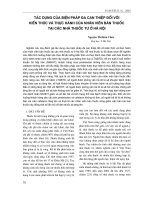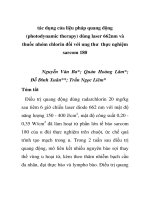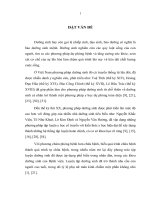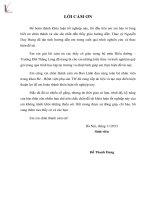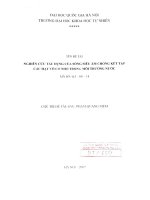TÁC DỤNG CỦA LIỆU PHÁP ÂM NHẠC CÓ NGUỒN GỐC TỪ NGŨ HÀNH TRONG Y HỌC CỔ TRUYỀN TRUNG QUỐC ĐỐI VỚI CHỨNG TRẦM CẢM SAU ĐỘT QUỴ
Bạn đang xem bản rút gọn của tài liệu. Xem và tải ngay bản đầy đủ của tài liệu tại đây (572.13 KB, 6 trang )
Online Submissions:
J Tradit Chin Med 2017 October 15; 37(5): 675-680
ISSN 0255-2922
© 2017 JTCM. This is an open access article under the CC BY-NC-ND license.
RESEARCH ARTICLE
TOPIC
Effect of music therapy derived from the five elements in Traditional
Chinese Medicine on post-stroke depression
Lin Facai, Huang Dehong, He Nana, Gu Yihuang, Wu Yunchuan
aa
Lin Facai, Gu Yihuang, Wu Yunchuan, The Second Clinical
College, Nanjing University of Chinese Medicine, Nanjing
210023, China
Huang Dehong, Department of Neurology, Guangzhou
Hospital of Traditional Chinese Medicien, Guangzhou
510006, China
He Nana, Henan University of Chinese Medicine, Zhengzhou 510006, China
Supported by State Administration of Traditional Chinese
Medicine of the People's Republic of China, State Clinical Research Base of Traditional Chinese Medicine, The Second Batch of Professional Skill Scientific and Research Special Project (No. JDZX2015127); Jiangsu Natural Science
Foundation Youth Project (No. BK20171070); Nanjing Scientific Development Planned Project (No. 201402057)
Correspondence to: Prof. Wu Yunchuan, The Second Clinical College, Nanjing University of Chinese Medicine, Nanjing
210023, China.
Telephone: +86-25-85811663
Accepted: December 9, 2016
Medicine theory twice daily. All treatments were administered for 5 d per treatment cycle for three cycles, with a 1 d interval between cycles. In all three
groups, Hamilton's depression scale (HAMD- 17)
score and the activities of daily life (ADL) score
were measured before and after treatment, and
side effects were assessed with the treatment emergent symptom scale.
RESULTS: The HAMD-17 score significantly decreased after treatment in all three groups, and the
post-treatment reduction in HAMD-17 score was
markedly greater in treatment group B than in
treatment group A (P < 0.01). The ADL score significantly increased after treatment in all three groups,
and the post-treatment increase in ADL score was
significantly greater in treatment group B than in
treatment group A (P < 0.01). The treatment emergent symptom scale score was highest in the control group, and lowest in group B, and significantly
differed between the three groups (P < 0.01).
Abstract
CONCLUSION: Five phase music therapy plus acupoint needling and acupoint injection can improve the symptoms in patients with post-stroke
depression.
OBJECTIVE: To evaluate the clinical efficacy and
safety of five phase music therapy in patients with
depression after ischemic stroke.
METHODS: A total of 92 patients with post-stroke
depression were randomly divided into the control
group (32 cases), treatment group A (30 cases), and
treatment group B (30 cases). All groups were given
basic therapies for cerebral infarction. In addition,
the control group was administerd 50 mg of oral
sertraline hydrochloride daily, while treatment
groups A and B received needling at Baihui (GV 20)
plus acupoint injection at Yanglingquan (GB 34) daily; treatment group B also received music therapy
derived from the five phases in Traditional Chinese
JTCM | www. journaltcm. com
© 2017 JTCM. This is an open access article under the
CC BY-NC-ND license.
Keywords: Depression; Stroke; Five phases therapy; Music therapy; Needling methods; Point GV20
(Baihui); Point GB34 (Yanglingquan)
INTRODUCTION
Depression is a condition that is defined as a series of
mood or emotional disorders characterized mainly by
675
October 15, 2017 | Volume 37 | Issue 5 |
Lin FC et al. / Research Article
symptoms of depression that occur due to various reasons.1 The morbidity of depression increases annually,
and it is predicted that it will become the second most
common disease following cardiac disease by 2020.2
Post-stroke depression (PSD) is a secondary type of depression. PSD impacts patient survival quality, inhibits
the rehabilitation of neurological and cognitive function, and increases mortality and disability, leading to
marked mental and physical pain of patients, and increasing their family and social burdens.3 A previous
meta-analysis reported that the morbidity of severe or
mild depression after stroke was 18% (range
8%-46%).4 PSD delays rehabilitation, and is a risk factor for low quality of life (QoL) and high mortality of
stroke patients.5,6
Although there are numerous studies on the pathogenesis of PSD, no study has interpreted the pathogenesis
from a single systematic aspect, as the development of
PSD involves multiple systems.7 The pathogenesis of
PSD is still unclear; hence, the treatment is difficult
and the effects of single western medicines are unsatisfactory. PSD treatment via Traditional Chinese Medicine (TCM) therapies has certain advantages. Music
therapy has a long history of use in treating emotional
conditions. Five phase music therapy is derived from
combining music therapy with the five phases in TCM
theory. Music therapies may have significant efficacy in
treating psychiatric conditions. Liao et al 8 proved that
five phase music therapy improved the QoL of patients
with advanced cancers, and Zhang et al 9 reported that
five phase music therapy improved the depression experienced by undergraduates.
In the present study, synchronal treatment of physical
and mental symptoms was conducted by acupoint injection combined with five phase music therapy in patients with PSD. The purpose of this study was to observe the effectiveness of acupoint injection combined
with five phase music therapy on the depression severity and QoL of patients with PSD, and to assess the
safety of this treatment.
the 4th National Academic Conference for Cerebrovascular Diseases (1995). Depression was diagnosed according to the Chinese Classification for Mental Disorders, version 3.12
Inclusion criteria
This study included patients who: met the Chinese
and western medicine diagnostic criteria of ischemic cerebral infarction and were diagnosed with cerebral infarction by skull CT and MRI; met the diagnostic criteria for depression, with a self-rating depression scale
and a Hamilton's depression scale (HAMD-17) score >
7 points; experienced secondary ischemic cerebral
stroke in the acute stage (2 weeks) within 6 months,
and had depression symptoms that lasted for > 2 weeks;
were aged 45-85 years; had stable vital signs and clear
consciousness and cooperated with physical examination with adequate communication ability; signed informed consent and voluntarily participated the study.
Exclusion criteria
This study excluded patients who: did not meet the diagnostic criteria; experienced ischemic stroke in the
acute stage within 2 weeks or in the sequelae stage >
6 months; were > 85 years old; had severe diabetes or
severe hepatorenal diseases; had unstable vital signs or
mental disease; had dementia, disturbance of consciousness and/or aphasia that might have influenced their expression of feelings; had taken antidepressants in the
previous 1 month; were allergic to Erigeron breviscapus or sertraline.
Intervention
Initial treatment was with western medicines. All enrolled patients were routinely treated in the Department of Neurology; treatment included administration
of trophic nerve drugs (citicoline sodium), improvement of blood circulation, control of blood pressure
and glucose, regulation of blood lipid concentration,
and cessation of platelet aggregation (aspirin) and other systematic therapies. TCM treatment included administration of Chinese drugs for activating blood to
remove blood stasis and smooth the meridians and collaterals (including Danhong injection and Xueshuantong injection), as well as rehabilitation therapies (including training of range of motion, enhancement of
myodynamia and posture correction). All drugs administered had no antidepressant effect. The three groups
were given basic treatment as well as the following:
Control group: 50 mg sertraline hydrochloride tablets
(Pfizer Pharmaceutical Co., Ltd.; approval No. H109
80141) in the morning.
Treatment group A: needling at Baihui (GV 20), and
acupoint injection at Yanglingquan (GB 34).
Treatment group B: the same treatment as treatment
group A, plus five phase music therapy. Music was selected based on the principle of treating emotional disturbance with hyperaffectivity. Acupuncture was conducted during one of the daily music therapy times.
MATERIALS AND METHODS
Setting and participants
A total of 92 patients with PSD hospitalized in the Department of Neurology in Guangzhou Hospital of
TCM from March 2014 to February 2015 were randomly divided into three groups using a computer-generated random number table:10 the control group (32
cases), treatment group A (30 cases), and treatment
group B (30 cases).
Diagnostic criteria
All patients met the diagnostic criteria of cerebral infarction according to the Western Medicine diagnostic
criteria for cerebral stroke in the Key Points of Diagnostic Criteria for Various Cerebrovascular Diseases11 from
JTCM | www. journaltcm. com
676
October 15, 2017 | Volume 37 | Issue 5 |
Lin FC et al. / Research Article
Baihui (GV 20) needling method: the acupoint was located according to international standards. Baihui (GV
20) is located 7 cun directly above the midpoint of the
posterior hairline, or at the junction of the midline at
the vertex with the line joining the two ear apexes. Disposable sterile needles were used (0.30 mm × 25 mm;
Wuxi Jiajian Medical Instrument Co., Ltd.,). The needle was inserted perpendicularly towards the posterior
brain, at an angle of 15° with the skin. The needle was
rapidly inserted 0.5-0.8 cun to the galea aponeurotica
substratum, and was twirled quickly with a combination of reinforcing and reducing methods. The needle was manipulated for 30 s at a frequency of 150200 times/min, until the patient felt a sore and swelling sensation locally. The needle was retained for 30 min,
during which time it was manipulated once every 10
min with the abovementioned method. After needle
withdrawal, the wound was pressed for 1-3 min to prevent hemorrhage and infection.
Method for acupoint injection at Yanglingquan (GB
34): patients were placed in lateral or supine position.
Acupoints were routinely located. A disposable 5 mL
syringe with a No. 5 needle was used to draw up 2 mL
of E. breviscapus (Yunnan Biovalley Pharmaceutical
Co., Ltd.,). The needle was inserted into the subcutaneous tissue at Yanglingquan (GB 34) slowly for 11.5 cun. After Qi arrival, non-refluxing blood was withdrawn through the needle and syringe, and then the E.
breviscapus was injected slowly along with syringe withdrawal. After needle withdrawal, the wound was
pressed for 1-3 min to prevent hemorrhage. The bilateral Yanglingquan (GB 34) sites were injected alternately, with the left side used one on odd-numbered days
and the right on even-numbered days for a cycle of
5 days (interval: 1 d).
Selection and measurement of five phase music therapy: according to the TCM syndrome differentiation results, emotionally antagonistic music was selected for
each patient using the principle of "The use of therapy
of one kind of sentiment restricts the opposite emotion", which meant that anger could restrict anxiety,
anxiety could restrict fear, fear could restrict happiness,
happiness could restrict sorrow, and sorrow could restrict anger. According to the principle that "anger restricts anxiety", the music Guangmingxing or Xuantian
Nuanfeng: Jiao Tiaoyang was selected; according to
"anxiety restricts fear", the music Meihua Sannong or
Huangting Jiaoyang: Gong Tiaoyang was chosen; according to "fear restricts joy", the music Hanjiang
Canyue or Fuyang Langzhao: Yu Tiaoyang was applied;
according to "joy restricts grief", the music Xixiangfeng or Yuhou Caihong: Zheng Tiaoyang was adopted;
according to "grief restricts anger", the music Jiangheshui or Wanxia Zhonggu: Shang Tiaoyang was used.
The music was played through a sound recorder, walkman or MP3 player, with the volume being increased
gradually to the appropriate level.
Therapeutic frequencies and course: Western MediJTCM | www. journaltcm. com
cine, needling and acupoint injection were administered once daily. Music therapy was administered twice
daily, once in the morning and once in the afternoon,
for 20 min per session. All treatments were administered in a 5 d cycle, for three continuous cycles, with
an interval between two cycles of 1 d.
Outcome measures
The efficacy and safety were evaluated in all groups after three treatment cycles (on day 18). The clinical efficacy was evaluated using the HAMD-17 and the activities of daily living scale (ADL), while safety was assessed using the Treatment Emergent Signs and Symptoms (TESS) adverse response scale.
HAMD-17 scores were evaluated in all groups before
and after treatment, and the therapeutic efficacy regarding depression symptoms was evaluated by the
HAMD-17 score reduction rate. The HAMD-17 score
reduction rate = (score before treatment - score after
treatment) / score before treatment × 100%. The diagnostic criteria of efficacy according to the HAMD-17
score reduction rate were: cured (reduction rate >
75% ), excellent (reduction rate 51%-75% ), effective
(reduction rate 25%-50% ), and non-effective (reduction rate < 25%).
Statistical data analysis
SPSS 18.0 (International Business Machines Corporation, Chicago, IL, USA) was used for data analysis. Data were expressed as the mean ± standard deviation ( xˉ
± s). One-way analysis of variance was performed, followed by the least significant difference method to test
the differences between groups. P < 0.05 was taken to
indicate a significant difference (two-tailed).
RESULTS
Comparison of baseline data between the three
groups before treatment
Before treatment, there was no significant difference between the three groups in age, sex, HAMD-17 score,
severity scale score (SSS) of neurological function, and
ADL score (all P > 0.05, Table 1), with a steady baseline and comparability.
A total of 113 patients with ischemic PSD were evaluated, with 94 meeting the inclusion criteria. Of the 94
included patients, 32 were assigned to the control
group, 30 to treatment group A, and 32 to treatment
group B. However, two patients in treatment group B
refused to continue treatment and withdrew from the
study, so there was a final total of 30 patients in treatment group B (Figure 1).
Control group treated with oral sertraline hydrochloride; treatment group A received needling at Baihui
(GV 20) and acupoint injection at Yanglingquan (GB
34); treatment group B received the same treatment as
treatment group A plus five phase music therapy.
677
October 15, 2017 | Volume 37 | Issue 5 |
Lin FC et al. / Research Article
Table 1 Baseline data of the three groups ( xˉ ± s)
Group
n
Male/female
Age (years)
HAMD
SSS
ADL
Control group
32
17/15
69.7±10.4
20.3±2.8
19.7±7.5
38.0±21.5
Treatment group A
30
10/20
72.9±10.4
19.5±4.1
20.7±8.5
32.7±22.5
Treatment group B
30
17/13
68.8±11.5
19.8±3.6
19.3±7.8
36.2±16.8
Notes: control group treated with oral sertraline hydrochloride; treatment group A received needling at Baihui (GV 20) and acupoint injection at Yanglingquan (GB 34); treatment group B received the same treatment as treatment group A plus five phase music therapy.
HAMD: Hamilton's depression scale; SSS: severity scale score; ADL: activities of daily living.
Assessed for eligbility
(n = 113)
Randomized
(n = 94)
Control group
(n = 32)
Treatment group A
(n = 30)
Treatment group B
(n = 32)
Lost to follow up
(n = 0)
Lost to follow up
(n = 0)
Lost to follow up
(n = 2)
Analyzed (n = 32)
Analyzed (n = 30)
Analyzed (n = 30)
Figure 1 Flowchart of study protocol
Activities of daily living score after treatment in the
three groups
There were significant improvements in ADL score after treatment in all three groups (P < 0.01). There was
no significant difference in the post-treatment change
in ADL score in the control group compared with treatment groups A and B (both P > 0.05), while treatment
group B had a significantly greater improvement in
ADL after treatment than treatment group A (P <
0.01, Table 3).
Hamilton depression scale scores
There was a significant difference in the HAMD-17
score before and after treatment in all three groups, indicating that all three methods significantly improved
HAMD-17 scores. The HAMD-17 score change was
significantly greater in treatment group B than in the
control group, and was the lowest in treatment group
A. There was no significant difference in the post-treatment HAMD-17 score change in either treatment
group compared with the control group (both P >
0.05), but treatment group B had a significantly greater reduction in HAMD-17 score than treatment group
A (P = 0.006, Table 2).
Treatment emergent signs and symptoms adverse
responses
The TESS adverse responses significantly differed
among the three groups after treatment (P < 0.01); the
TESS score was the lowest in treatment group B and
the highest in the control group, and was notably lower in both treatment groups A and B than in the control group (Table 4).
Hamilton depression scale scores in the three groups
Of all enrolled patients, the post-treatment change in
the HAMD-17 score was excellent in one, effective
in 61, and non-effective in 30, with an overall response rate (ORR) of 67.4%. The ORR according
to the HAMD-17 score did not significantly differ
between the control group (59.4% ), treatment
group A (63.3% ), and treatment group B (80% )
(P > 0.05), illustrating that the three methods were
similar in clinical efficacy in treating patients with
PSD.
JTCM | www. journaltcm. com
DISCUSSION
The present study found that the HAMD-17 score significantly decreased after treatment in all groups, and
that the effective rate was 59.4% in the western medi678
October 15, 2017 | Volume 37 | Issue 5 |
Lin FC et al. / Research Article
Table 2 Comparison of HAMD-17 score in the three groups before and after treatment ( xˉ ± s)
Group
Before treatment
After treatment
Difference value
t value
P value
Control group
20.3±2.8
14.8±2.1
5.5±1.8
16.825
<0.001
Treatment group A
19.5±4.1
14.6±4.1
4.9±1.5
17.476
<0.001
Treatment group B
19.8±3.6
13.6±2.7
6.2±2.1
16.240
<0.001
F value
0.389
1.344
3.955
-
-
P value
0.679
0.226
0.023
-
-
Notes: control group treated with oral sertraline hydrochloride; treatment group A received needling at Baihui (GV 20) and acupoint injection at Yanglingquan (GB 34); treatment group B received the same treatment as treatment group A plus five phase music therapy.
HAMD-17: Hamilton's depression scale.
Table 3 Comparison of ADL scores in the three groups before and after treatment ( xˉ ± s)
Group
Before treatment
After treatment
Difference value
t value
P value
Control group
38±22
53±21
-15±5
-15.748
<0.001
Treatment group A
33±22
45±24
-12±5
-12.577
<0.001
Treatment group B
36±17
54±19
-18±5
-18.015
<0.001
F value
0.535
1.513
7.378
-
-
P value
0.588
0.226
0.001
-
-
Notes: control group treated with oral sertraline hydrochloride; treatment group A received needling at Baihui (GV 20) and acupoint injection at Yanglingquan (GB 34); treatment group B received the same treatment as treatment group A plus five phase music therapy.
Table 4 Comparison of the TESS scale scores in the three
groups ( xˉ ± s)
Group
n
Score
Control group
32
4.2±1.5
Treatment group A
30
Treatment group B
Total
χ2 value
Jue-tone music alleviates the depression of patients
with cerebral stroke,13 and musical electroacupuncture
improves the gastrointestinal somatization of patients
with PSD.14 The present study results were consistent
with the abovementioned studies, suggesting that music therapy could improve the somatization and also
the psychiatric syndromes with high safety in patients
with PSD.
The functional mechanism of music therapy has not
yet been clarified. One previous study suggested that
music therapy markedly increased 5-hydroxytryptamine (5-HT) and norepinephrine (NE) contents in the
brains of mice with depression,15 indicating that music might regulate the central neurotransmitters by increasing the release of 5-HT in the central nervous system and promoting NE concentration in hypothalamus to prevent and treat depression. Zhang et al 16 also
demonstrated that music with the Gong tone in five
phase music upregulated patients' immune function,
which provided an adjuvant therapeutic effect in TCM
syndromes due to liver depression and spleen deficiency. Music therapy is easily accepted by patients, as it is
simple, convenient, economical and safe, and avoids the
adverse reactions caused by acupuncture and drug administration. The effectiveness of music therapy is being increasingly recognized, but its functional mechanism is yet to be further studied. In the present study,
the five phase music of emotional inter-resistance was
selected; in a future study, music associated with the corresponding emotion will be selected to determine the
optimal music for the treatment of patients with PSD.
One of the disadvantages of the present study was the
lack of long-term efficacy observation and follow-up.
Furthermore, the present study only included patients
P value
53.822
< 0.001
2.3±0.9
-
-
30
1.4±0.7
-
-
92
2.7±1.6
-
-
Notes: control group treated with oral sertraline hydrochloride;
treatment group A received needling at Baihui (GV 20) and acupoint injection at Yanglingquan (GB 34); treatment group B received the same treatment as treatment group A plus five phase
music therapy. TESS: treatment emergent signs and symptoms.
cine group, 63.3% in the acupoint injection group,
and 80% in the five phase music therapy group. There
was no significant difference between the three groups
in post-treatment HAMD-17 score change, indicating
that all treatments resulted in similar improvements in
the depression severity of patients with PSD; however,
acupoint injection combined with five phase music
therapy tended to result in the greatest reduction in
HAMD-17 score. The ADL score significantly increased after treatment in all three groups, suggesting
that all methods improved patients' ADL; acupoint injection combined with five phase music therapy was
better than acupoint injection alone in clinical efficacy.
There were significant differences between the three
groups in the TESS score of adverse responses after
treatment, which was the highest in the Western Medicine group, and the lowest in the five phase music therapy group, demonstrating that acupoint injection plus
five phase music therapy was markedly safer than western medicine. Previous research has shown that
JTCM | www. journaltcm. com
679
October 15, 2017 | Volume 37 | Issue 5 |
Lin FC et al. / Research Article
with cerebral infarction in the convalescence stage and
excluded those in the acute stage and sequelae stage,
which limits the scope of the study findings.
In conclusion, our findings suggest that acupoint stimulation and acupoint injection plus five phase music
therapy had a significant effect in the treatment of patients with PSD, and that the effect of this combination therapy was significantly better than using acupoint stimulation and acupoint injection alone, which
was superior to conventional treatment for PSD. Acupoint injection plus music therapy may be a promising
therapy for PSD treatment.
7
8
9
10
11
ACKNOWLEDGMENTS
The authors wish to thank the physicians in the Department of Neurology at Guangzhou Hospital of
TCM for their great support and help.
12
REFERENCES
1
2
3
4
5
6
13
Edge L. Tackling the global burden of stroke. Lancet Neurol 2005; 4(11): 689.
Zhang JZ. Advances of foreign antidepressants and
their domestication status. Shanghai Yi Yao 2003; 24
(6): 270.
Duan PX, Wu SY. Advances of integrated Chinese and
Western research on mechanism of post-stroke depression.
Zhong Xi Yi Jie He Xin Nao Xue Guan Bing Za Zhi
2011; 9(1): 104-106.
Meader N, Moe-Byrne T, Llewellyn A, et al. Screening
for post¬stroke major depression: a Meta-analysis of diagnostic validity studies. J Neurol Neurosurg Psychiatry
2014; 85(2): 198-206.
Loubinoux I, Kronenberg G, Endres M, et al. Post-stroke
depression: mechanisms, translation and therapy. J Cell
Mol Med 2012; 16(9): 1961-1969.
Hornsten C, Lovheim H, Gustafson Y. The association
between stroke, depression, and 5-year mortality among
JTCM | www. journaltcm. com
14
15
16
680
very old people. Stroke 2013; 44(9): 2587-2589.
Lin FC, Huang DH. Research progression on biological
mechanism of post-stroke depression. J Int Transl Med
2014; 2(2): 336-340.
Liao J, Yang YF, Lorenzo Cohen, Zhao YC, Xu Yl. Effects of Chinese medicine five-element music on the quality of life for advanced cancer patients: a randomized controlled trial. Chin J Integr Med 2013; 19(10): 736-740.
Zhang B, Chen Y, Qiu ZY. Influence of TCM five-elementmusic therapy on depression of undergraduates. Nanjing Zhong Yi Yao Da Xue Xue Bao (Social Sci) 2014; 15
(2): 115-117.
Wan X, Liu JP. Random grouping methods in clinical trials. Zhong Yi Za Zhi 2007; 48(3): 216-219.
Society of Neurosurgery, Chinese Medical Association.
Key points in diagnosis of various cerebrovascular diseases
in the fourth national academic conference for cerebrovascular diseases. Zhong Hua Shen Jing Ke Za Zhi 1996; 29
(6): 379.
Chinese Society of Neurology. Chinese Classification and
Doagmpstoc Criteria of Mental Disorders version 3 (CCMD-3). Jinan: Shandong Science and Technology Press,
2001: 87-89.
Hu J, Cai W. Study on effect of five lines musical tone
horn on depression after stroke. Hu Li Yan Jiu 2014; 28
(6): 1990-1991.
Yang F, Yang FZ, Liu JY. Comparison of the Effectiveness
of pulsed electroacupuncture and musical electroacupuncture treating patients with depression in gastrointestinal somatic symptoms after stroke. Nanjing Zhong Yi Yao Da
Xue Xue Bao 2014; 30(3): 225-228.
Cheng HY, Xiong HZ, Zhu JX, Xu F, Li L. Study on influence of TCM five-element musical therapy on behaviors and cerebral 5-hydroxytryptamine and norepinephrine in model mice with depression. Zhong Guo Kang Fu
Yi Xue Za Zhi 2015; 30(7): 712-714.
Zhang SY, Peng GY, Gu LG, et al. Effect and Mechanisms of Gong-Tone Music on the Immunological Function in Rats with Liver(Gan)-Qi Depression and Spleen
(Pi)-Qi Deficiency Syndrome in Rats. Chin J Integr Med
2013; 19(3): 212-216.
October 15, 2017 | Volume 37 | Issue 5 |
